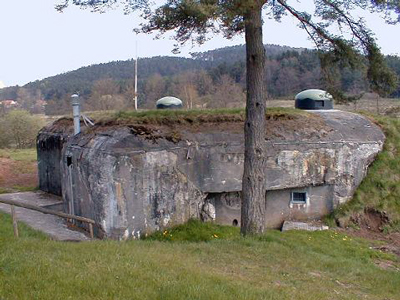
WWII: Maginot Line | Normandy | V-Weapon Sites | Arnhem
Further afield: Crete
| Home Tracing Military Ancestors Travel Advice CWGC Cemeteries Iron Harvest News Book Reviews Glossary Links Contact Me Maginot Line:
 
|
Key Fortification TypesInterval Casemates
Two story (ground floor and basement) concrete structures with a platoon-sized garrison of one officer and 30 other ranks armed with either two machine guns or a machine gun and 37mm/47mm anti-tank gun. Firing chambers were constructed to fire along the Maginot Line so as to catch attacking units in flank when they had reached the surrounding anti-tank obstacles and barbed wire and were, therefore, at their most vulnerable. This arrangement also protected the firing embrasures from direct enemy fire allowing the front of the casemates facing the enemy to be concealed and protected with banked earthworks. Walls were of reinforced concrete and typically 2-2.25 metres thick. Ditches provided an additional obstacle for infantry attacking the embrasures and prevented debris from blocking the openings. Entrance was gained via an armoured door in the rear of the structure, employing a retractable drawbridge to prevent attacking infantry planting explosives to gain access. Steel “cloches” (literally “bells” in French due to their shape) 25-30cm thick were built on the roof of the casemate to provide observation of the surrounding area and/or additional machine-gun posts for protection. Due to lessons learnt during the fighting for the Verdun forts in 1916, each casemate was designed to operate even when completely surrounded. Each included accommodation, substantial stores of food and water and electric power which, not only provided light, but also ran a clear air filter which meant that the casemate could still function during a poison gas attack. Remotely operated searchlights, which would give each casemate a day and night defensive capability, were in the process of being installed when the Second World War began. The "Ouvrages"
Major defensive works in many different variations depending on location and local topography. Divided between "gros ouvrages" and “petit ouvrages” (basically "large works" and "small works"), the main difference being that "petit ouvrages'" only mounted infantry weapons (e.g. machine guns and anti-tank guns) whilst the “gros ouvrages” mounted infantry weapons and artillery. Altogether there were 31 “petit ouvrages” and 22 “gros ouvrages” along the Franco-German border. "Ouvrages" were made up of a varying number of combat blocks supported by underground barrack accommodation for up to 1,000 men, power plant, magazines, stores and command and control facilities. In fact, only the "cloches", weapons turrets, defensive casemates and entrance blocks of an "ouvrage" would be visible from the surface. Exposed walls were between 2.75 and 3.5 metres thick and were designed to withstand artillery fire up to and including 420mm howitzers. Armament of the “ouvrages” varied as much as their size and shape. From the infantry weapons of the "petit ouvrages" though "ouvrages" such as Fort Schoenenbourg mounting four 75mm guns, two 81mm mortars and supporting anti-tank guns, grenade launches and machine guns, to the massive Fort Hackenberg near Thionville mounting four 135mm howitzers, nine 75mm guns and four 81mm mortars. |
